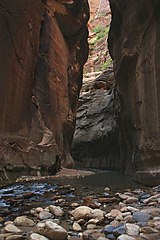Slot canyon
This article includes a list of general references, but it lacks sufficient corresponding inline citations. (February 2008) |

A slot canyon is a narrow canyon, formed by the wear of water rushing through rock. A slot canyon is significantly deeper than it is wide. Some slot canyons can measure less than 1 metre (3 ft) across at the top but drop more than 30 metres (100 ft) to the floor of the canyon.
Many slot canyons are formed in sandstone and limestone rock, although slot canyons in other rock types such as granite and basalt are possible. Even in sandstone and limestone, only a very small number of creeks will form slot canyons due to a combination of the particular characteristics of the rock and regional rainfall.
Slot canyons around the world
Slot canyons are found in many parts of the world, predominantly in areas with low rainfall. Some of the best-known slot canyons are to be found in the Southwestern United States. Other significant areas include the Sierra de Guara in northern Spain, the Pyrenees on the border of France and Spain, and the Blue Mountains in New South Wales, Australia.

Australia
The largest known area of slot canyons in Australia is in the Blue Mountains, west of Sydney. They occur in a narrow band of sandstone that runs roughly 30 kilometres (19 mi) from east to west, and about 100 kilometres (62 mi) from south to north. The majority of these canyons are in the Wollemi Wilderness, and are difficult to access. A small number are regularly visited by canyoners on weekends in summer. The Grand Canyon, near Blackheath, has a tourist track along its rim, but requires abseiling (rappelling) or swimming to visit fully.
Sandstone slot canyons can also be found in a few more remote parts of Australia, including Karijini National Park and the Bungle Bungles in Purnululu National Park, both in Western Australia, and Carnarvon Gorge in Queensland.

United States
Southern Utah has the densest population of slot canyons in the world with over one-thousand slot canyons in the desert lands south of Interstate 70.[1] Utah's slot canyons are found in Zion National Park at The Narrows, along Canyonlands National Park's Joint Trail, throughout Capitol Reef National Park, within the San Rafael Swell and the Grand Staircase-Escalante National Monument, especially along the Escalante River drainage including Coyote Gulch. Many more slot canyons are located on public Bureau of Land Management and state-owned lands in southern Utah, in areas surrounding the aforementioned parks and monuments. Buckskin Gulch—one of the longest slot canyons in the world—begins in southern Utah and continues into northern Arizona within the Paria Canyon-Vermilion Cliffs Wilderness. Northern Arizona also has a high concentration of slot canyons including Antelope Canyon and Secret Canyon, which are two of the most famous slot canyons located near Page on land owned by the Navajo Nation. Slot canyons are also located in the valley between U.S. Route 89 and the Vermilion Cliffs in Arizona, and can be seen as one descends into the valley on U.S. 89, but these are on the Navajo reservation and are closed to the public. The Kasha-Katuwe Tent Rocks National Monument's slot canyon trail in New Mexico is unique as it was carved into tuff (volcanic ash). In California, several slot canyons are located within Death Valley National Park.

Drowning danger
Local as well as distant storms can cause dangerous flash flooding in slot canyons, and hikers should not enter them if there is any sign of rain in the surrounding area.[2] In many slot canyons, it can be miles before a safe exit or rescue is possible.
On August 12, 1997, eleven tourists, including seven from France, one from the United Kingdom, one from Sweden and two from the United States, were killed in Lower Antelope Canyon by a flash flood.[3][4] Very little rain fell at the site that day, but an earlier thunderstorm had dumped a large amount of water into the canyon basin, seven miles upstream. The lone survivor of the flood was tour guide Francisco "Poncho" Quintana, who had prior swift-water training. At the time, the ladder system consisted of amateur-built wood ladders that were swept away by the flash flood. Today, ladder systems have been bolted in place, and deployable cargo nets are installed at the top of the canyon. A NOAA Weather Radio from the National Weather Service and an alarm horn are stationed at the fee booth.[5]
Gallery
-
Taminaschlucht, Tamina River, Switzerland
-
The Narrows, Zion National Park, Utah
-
Kasha-Katuwe, New Mexico
References
- ^ Zion slot canyons
- ^ "Safety Tips". blm.gov. Bureau of Land Management. 2016-03-24. Archived from the original on 2016-09-30. Retrieved 1 November 2016.
{{cite web}}: Unknown parameter|deadurl=ignored (|url-status=suggested) (help) - ^ "Flash Flood Antelope Canyon". Retrieved 2006-03-20.
- ^ "Antelope Canyon". Archived from the original on 17 March 2006. Retrieved 2006-03-20.
{{cite web}}: Unknown parameter|deadurl=ignored (|url-status=suggested) (help) - ^ Kramer, Kelly (2008). "Man vs. Wild". Arizona Highways. 84 (11): 23.
External links
![]() Media related to Slot canyons at Wikimedia Commons
Media related to Slot canyons at Wikimedia Commons




